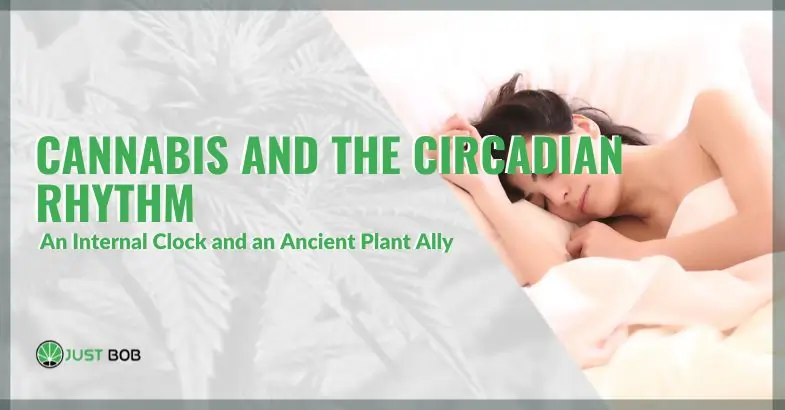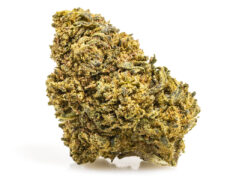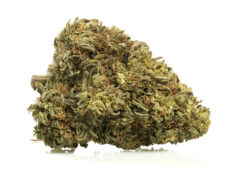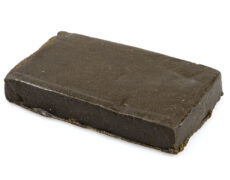Published on: 11/06/2025
An Internal Clock and an Ancient Plant Ally
Our bodies dance to the beat of an invisible metronome, an internal biological clock known as the circadian rhythm. This finely tuned mechanism orchestrates a myriad of essential physiological processes, from the sleep-wake cycle to body temperature, hormone secretion and energy metabolism.
Keeping this rhythm synchronised with the natural day-night cycle is crucial for our overall health and well-being.
At the same time, cannabis, a plant used by humans for thousands of years for various purposes, is experiencing a renaissance of scientific interest.
Beyond its notoriety, research is beginning to reveal the complex interactions between its compounds, cannabinoids such as THC and CBD, and our body, particularly with the endocannabinoid system, a cellular communication system that also appears to play a key role in regulating circadian rhythms.
This article by Justbob explores the fascinating and surprising connection between cannabis and our biological clock, analysing how the different components of the plant can influence this delicate balance and what current research suggests, always remembering the importance of an informed and conscious approach to this plant and its derivatives, such as cannabis light products, which are appreciated for their aromatic properties and intended for uses such as collecting or technical use in many European countries.
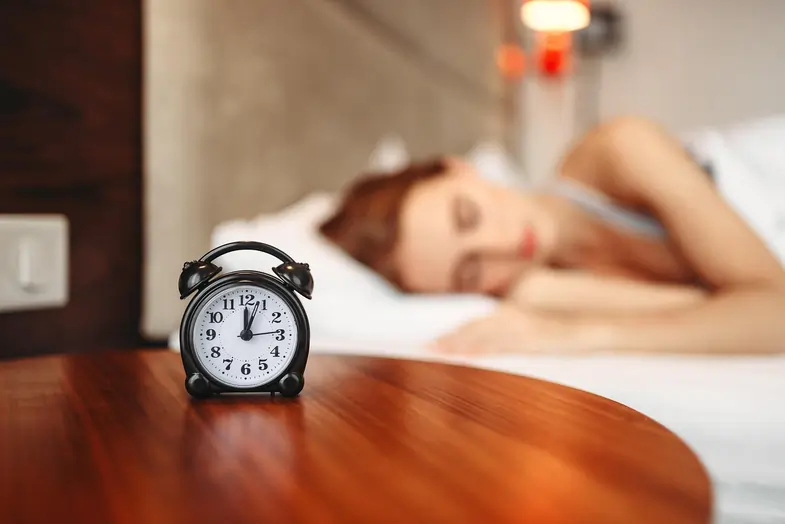

What is the Circadian Rhythm and Why is it Essential?
The term ‘circadian’ comes from the Latin circa diem, meaning ‘around the day’, and perfectly describes the cyclical nature of this system. The circadian rhythm is our internal biological clock, an endogenous mechanism that regulates physiological and behavioural functions over a cycle of approximately 24 hours.
The main control centre of this clock is located in the suprachiasmatic nucleus (SCN), a small region of the hypothalamus in the brain. This ‘master clock’ receives direct signals from the external environment, mainly light captured by the retina, and uses them to synchronise the peripheral clocks found in almost all organs and tissues of the body.
Essentially, daylight signals the SCN to promote wakefulness and activity, while darkness stimulates the release of melatonin, the hormone that induces sleep.
This dynamic balance ensures that processes such as restorative sleep, cell repair, hormone production (cortisol, growth hormone), body temperature regulation and blood pressure occur at optimal times.
When this rhythm is disrupted – due to jet lag, night work, excessive exposure to artificial light at night or poor sleep habits – the entire body suffers, leading to fatigue, difficulty concentrating and, in the long term, an increased risk of health problems.
Understanding how the circadian rhythm works is therefore essential to appreciating the importance of maintaining a regular lifestyle and the impact that various factors, including cannabis-derived compounds, can have on this delicate biological mechanism.
Read also: CBD oil for sleep and relaxation: how does it works?
The Endocannabinoid System: The Bridge Between Cannabis and Biological Rhythm
At the centre of the interaction between cannabis and our internal clock is the endocannabinoid system (ECS). Discovered relatively recently, the ECS is a complex system of cellular communication present throughout the mammalian body, involved in the regulation of a wide range of physiological functions aimed at maintaining homeostasis, or the internal balance of the body.
The ECS is mainly composed of three elements: endocannabinoids (such as anandamide and 2-AG), cannabinoid-like molecules produced by our own bodies; cannabinoid receptors (mainly CB1 and CB2), to which endocannabinoids and phytocannabinoids (such as THC and CBD) bind; and enzymes responsible for the synthesis and degradation of endocannabinoids.
Research has shown that the SEC plays a significant role in regulating the sleep-wake cycle and circadian rhythms. For example, levels of endocannabinoids such as anandamide naturally fluctuate throughout the day, with peaks that appear to promote sleep.
The expression of CB1 receptors, which are abundant in the brain and the SCN itself, also follows a circadian rhythm, being higher during the day. This intrinsic rhythmicity suggests that the ECS is not only regulated by the biological clock, but may also actively influence it.
Phytocannabinoids found in cannabis, such as THC (which binds strongly to CB1 receptors) and CBD (which interacts with the SEC in more complex ways), can therefore ‘communicate’ with this system, modulating its activity and, as a result, potentially influencing circadian rhythms and the delicate sleep-wake balance.
THC and Circadian Rhythm: Effects on the Sleep-Wake Cycle
Delta-9-tetrahydrocannabinol (THC) is the main psychoactive compound in cannabis, known for its euphoric and sedative effects. Its interaction with the circadian rhythm and the sleep-wake cycle is complex and seems to depend on factors such as dosage, frequency of use and individual characteristics.
Initial studies, both in animal models and in humans, suggest that acute THC intake, especially at low doses, may have sedative effects, facilitating sleep onset and reducing the time needed to fall asleep. Some research also indicates an increase in deep sleep (non-REM) and a concomitant reduction in REM (Rapid Eye Movement) sleep, the phase associated with dreaming. This reduction in REM sleep may explain why a decrease in dream recall is sometimes reported in conjunction with THC use.
However, the picture changes with chronic use or higher doses.
Prolonged use of THC can lead to tolerance to the initial sedative effects and, paradoxically, to a reduction in overall sleep quality. Sleep fragmentation and negative alterations in circadian rhythms may occur, affecting the natural alternation between sleep and wakefulness.
Sudden discontinuation of chronic use can also cause withdrawal symptoms, including insomnia and vivid or unusual dreams (a ‘rebound’ of REM sleep), further worsening sleep disorders.
It is therefore clear that THC’s influence on our biological clock is not straightforward: while it can induce short-term drowsiness, prolonged or excessive use can significantly disrupt the delicate mechanism of the circadian rhythm and the quality of night-time rest.
CBD and Circadian Rhythm: A Potential Regulator?
Unlike THC, cannabidiol (CBD) is a non-psychoactive cannabinoid that is attracting great interest for its potential beneficial properties without inducing the ‘high’ effect. Found in numerous legal products, such as CBD oil, its interaction with the circadian rhythm and sleep appears to be different and potentially more modulating than THC.
Research suggests that cannabidiol does not have a direct sedative effect like THC at low doses; in fact, some studies indicate that it may promote alertness at low doses. However, CBD appears to influence sleep primarily in an indirect way, by acting on factors that can disrupt rest, such as anxiety and stress.
Numerous preclinical studies and some preliminary clinical studies indicate that CBD has anxiolytic and relaxing properties. By reducing anxiety, which is a common cause of insomnia and sleep disorders, this molecule could facilitate falling asleep and improve overall sleep quality.
Some research also suggests that CBD may positively influence the circadian rhythm itself, helping to restore balance to the sleep-wake cycle, a potentially useful effect for those suffering from jet lag or working shifts.
In addition, studies of patients with REM sleep behaviour disorder (associated with nightmares and physical movements during sleep) have shown that cannabidiol may reduce these symptoms.
The Importance of Timing: When the Interaction Occurs
When considering the interaction between cannabis and the circadian rhythm, the timing of consumption emerges as a potentially crucial factor, although it has not yet been systematically studied in humans, partly due to the fact that its consumption is still strictly prohibited in most countries.
Since our biological clock regulates different processes depending on the time of day and night, it is logical to assume that the introduction of compounds such as THC and CBD may have different effects if taken in the morning, afternoon or evening. For example, the sedative effect of THC may be perceived as more pronounced when taken in the evening, when the body is already preparing for sleep, whereas it may cause unwanted drowsiness when taken during the day. Conversely, the potential alertness-promoting effect of CBD at low doses may be more useful in the morning, while its anxiolytic properties may be more desirable in the evening to promote relaxation before bedtime.
Research suggests that the endocannabinoid system itself has its own rhythm, with endocannabinoid levels and receptor expression varying over a 24-hour period. Interacting with this system at different times in its natural cycle could therefore lead to different responses.
Altering the circadian rhythm with cannabis use, especially chronically or at the ‘wrong’ times relative to one’s biological clock, may contribute to internal desynchronisation, similar to that experienced with jet lag or shift work. This desynchronisation can have cascading effects on overall health.
Although specific human studies defining the time-dependent effects of different cannabinoids on the circadian rhythm are lacking, it is reasonable to consider timing as a key factor. Understanding how ‘when’ influences ‘how’ cannabis interacts with our biological clock is an important area for future research, critical for a more comprehensive understanding of this complex relationship.


Beyond Cannabinoids: The Role of Terpenes
The interaction between cannabis and circadian rhythm is not determined solely by THC and CBD. The cannabis plant is a complex phytochemical containing hundreds of compounds, including terpenes, aromatic molecules responsible for the characteristic smells and flavours of different strains. These compounds are not simply ‘scents’, but have their own biological activities and can interact synergistically with cannabinoids, a phenomenon known as the ‘entourage effect’.
Some terpenes have been associated with specific effects that may influence sleep and wakefulness. For example, myrcene, found in many varieties and also in plants such as hops and mango, is known for its potential sedative and muscle-relaxing properties. Linalool, abundant in lavender, is also being studied for its calming and anxiolytic effects. Other terpenes, such as limonene (found in citrus fruits) or pinene (found in pine), are often associated with more energising and mood-enhancing effects.
The specific combination of cannabinoids and terpenes (the ‘chemotype’) of a particular cannabis strain could therefore modulate its overall effect on the circadian rhythm. This is particularly relevant for cannabis light, which, despite having very low THC levels, is rich in CBD and has varied terpene profiles. CBD buds, for example, are often appreciated precisely for their distinctive aromatic notes, derived from terpenes, and are legally available in many European countries, albeit not for consumption but for uses such as collecting, research, technical use or aromatherapy, excluding human consumption.
The aroma itself, conveyed by terpenes, can have an impact on relaxation and mood, indirectly influencing the predisposition to sleep or wakefulness. Therefore, considering the entire phytocomplex, including terpenes, is essential to fully understand the potential influence of cannabis, including light cannabis, on our biological clock.
Read also: CBD: Properties and Benefits of cannabidiol
A Complex and Promising Field of Research
Exploring the relationship between cannabis and circadian rhythm reveals a fascinating but still complex picture.
It is clear that our internal biological clock and the endocannabinoid system are intrinsically linked, and that cannabis compounds, such as THC and CBD, can interact with this system, potentially modulating the sleep-wake cycle and other circadian rhythms. However, the effects are not straightforward: THC can induce short-term drowsiness but disrupt sleep and rhythms with chronic use, while CBD appears to act more indirectly, possibly regulating anxiety and promoting balance.
The importance of timing and the synergistic role of terpenes add further layers of complexity to this interaction.
It is important to emphasise that much of the current research is based on preclinical studies or small human studies, and further rigorous investigation is needed to fully understand the mechanisms of action and long-term implications.
Cannabis and the circadian rhythm: takeaways
- Our bodies follow an internal rhythm of about 24 hours, regulated by the suprachiasmatic nucleus and influenced by external cues like light. The endocannabinoid system (ECS), composed of receptors and naturally produced molecules, displays its own circadian rhythm and interacts with the biological clock. Phytocannabinoids found in cannabis – especially THC and CBD – can modulate ECS activity, thereby influencing the sleep-wake cycle and other key physiological processes governed by this internal timing system.
- THC, when used occasionally and in low doses, may help initiate sleep and deepen non-REM phases. However, chronic or high-dose use can disrupt sleep architecture, reduce sleep quality, and lead to withdrawal-induced insomnia when stopped. CBD, in contrast, does not act as a sedative but may indirectly improve sleep by reducing anxiety and stress. At low doses, it can even promote alertness, while its relaxing effects become more helpful in the evening, making it a potential modulator of circadian stability.
- The effects of cannabis on circadian rhythms vary depending on the time of day it is consumed. THC may be more sleep-promoting in the evening but cause unwanted drowsiness during the day. Meanwhile, terpenes – the aromatic compounds in cannabis – also play a role: some (like myrcene and linalool) support relaxation, while others (such as limonene or pinene) are linked to energy and focus. The specific combination of cannabinoids and terpenes, known as the “chemotype,” is therefore key to understanding how cannabis interacts with the body’s internal clock.
Cannabis and the circadian rhythm: FAQ
What is the circadian rhythm and why is it important?
The circadian rhythm is our internal biological clock that regulates physiological and behavioral functions over a roughly 24-hour cycle. Its main control center is located in the suprachiasmatic nucleus of the brain and it synchronizes with natural light. It plays a key role in processes like sleep, hormone production, and body temperature regulation. When disrupted, it can cause fatigue, difficulty concentrating, and, over time, increased health risks.
What role does the endocannabinoid system play in the circadian rhythm?
The endocannabinoid system (ECS) regulates many physiological functions, including the sleep-wake cycle and circadian rhythm. Endocannabinoids like anandamide fluctuate naturally throughout the day. CB1 receptors, found in the brain and the suprachiasmatic nucleus, also show rhythmic expression. Phytocannabinoids like THC and CBD can interact with the ECS, potentially influencing circadian balance and sleep patterns.
What is the difference between the effects of THC and CBD on the circadian rhythm?
THC, at low doses, may help induce sleep by shortening the time needed to fall asleep, but chronic or high-dose use can disrupt the circadian rhythm and reduce sleep quality. CBD does not act as a sedative but may improve sleep indirectly by reducing anxiety and stress. It may also help restore balance to the sleep-wake cycle, making it potentially useful for people with jet lag or shift work schedules.

